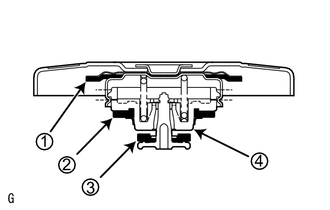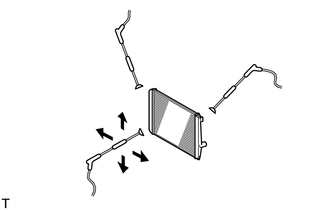Toyota Tacoma (2015-2018) Service Manual: On-vehicle Inspection
ON-VEHICLE INSPECTION
PROCEDURE
1. INSPECT RADIATOR CAP SUB-ASSEMBLY
CAUTION:
Do not remove the radiator cap sub-assembly while the engine and radiator assembly are still hot. Pressurized, hot engine coolant and steam may be released and cause serious burns.
(a) Measure the valve opening pressure.

(1) If there are water stains or foreign matter on rubber packing 1, 2 or 3, clean it by using water and finger scouring.
(2) Check that rubber packing 1, 2 and 3 are not deformed, cracked or swollen.
(3) Check that rubber packing 3 and 4 are not stuck together.
(4) Apply engine coolant to rubber packing 2 and 3.
|
(5) When using the radiator cap tester, tilt it 30° or more. Text in Illustration
|
|
(6) Pump the radiator cap tester several times and check the maximum pressure.*1
Pumping speed:
1 pump per second
HINT:
*1: Even if the radiator cap sub-assembly cannot maintain the maximum pressure, it is not necessarily defective.
Standard Judgment Criterion:
|
Item |
Specified Condition |
|---|---|
|
Standard value (for brand-new cap) |
93 to 123 kPa (1.0 to 1.3 kgf/cm2, 14 to 18 psi) |
|
Minimum standard value (for used cap) |
79 kPa (0.8 kgf/cm2, 11 psi) |
If the maximum pressure is less than the minimum standard value, replace the radiator cap sub-assembly.
2. INSPECT FINS FOR BLOCKAGE
|
(a) If the fins are clogged, wash them with water or a steam cleaner and dry them with compressed air. NOTICE:
|
|
(b) Dry the fins with compressed air.
 Components
Components
COMPONENTS
ILLUSTRATION
ILLUSTRATION
ILLUSTRATION
...
 Disassembly
Disassembly
DISASSEMBLY
PROCEDURE
1. REMOVE RADIATOR DRAIN COCK PLUG
(a) Remove the radiator drain cock plug from the radiator assembly.
(b) Remove the O-ring from the radiator drain cock plug.
2. REMOVE RAD ...
Other materials:
Inverter Relay
On-vehicle Inspection
ON-VEHICLE INSPECTION
PROCEDURE
1. INSPECT INVERTER RELAY
(a) Check the resistance.
(1) Measure the resistance according to the value(s) in the table below.
Standard Resistance:
Tester Connection
Condition
...
Check Bus 3 Lines for Short Circuit
DESCRIPTION
There may be a short circuit between the CAN main bus lines and/or CAN branch
lines when the resistance between terminals 6 (CA3H) and 21 (CA3L) of the central
gateway ECU (network gateway ECU) is below 54 Ω.
Detection Item
Trouble Area
Resis ...
Removal
REMOVAL
PROCEDURE
1. DRAIN DIFFERENTIAL OIL
2. REMOVE PROPELLER WITH CENTER BEARING SHAFT ASSEMBLY (for 2WD)
3. REMOVE PROPELLER WITH CENTER BEARING SHAFT ASSEMBLY (for 4WD)
4. REMOVE REAR DRIVE PINION NUT
(a) Using SST and a hammer, unstake the nut.
SST: 09930-00010
(b) for BD20:
...


